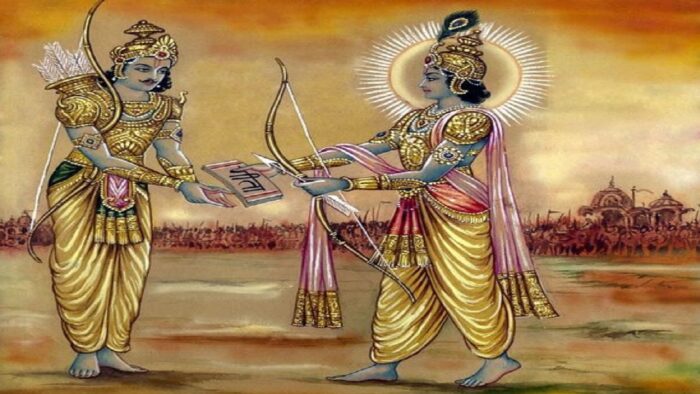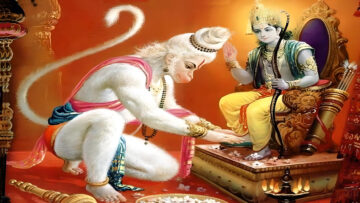Introduction
Tradition of vedānta maintains that cultivating the śāstra pramānika buddhi (i.e. conviction to treat śāstra as the means of knowledge, like one’s eye is a means of knowledge), allows us to achieve permanent relief from suffering – not just a temporary relief. This śāstra pramānika buddhi, which is synonymous with the word śraddha, helps one to gain knowledge [BG 4.34] with which one overcomes all notions of finitude of self, in this very life itself. One such precious śāstra is the Bhagavad Gītā, which Śri Śaṃkara extolls as samasta-vedārtha-sāra-saṅgraha-bhūtaṃ (quintessence of all Vedas). The great epic Mahābhārata is itself treated as the very extension of Vedas (See Mbh 1.57.74). We shall herewith examine few aspects pertaining to the spiritual significance of Gītā.
- Gītā’s influence encompasses all of life
Spirituality ought to encompass all walks of life. The notion of segregating life into spiritual and the secular silos, is not the vedic view of life. Dharma as per vedic view is that which guides one and all, in both the spheres – namely the sphere of action (pravrrti) and the realm of actionless abidance (nivrrti). While in domain of pravrrti (sphere of action), spirituality (i.e. Dharma) ought to grant us abhyudaya (i.e. holistic all-round wellbeing) and prepare us for niḥśreyasa (i.e. complete cessation of suffering throughdoubtless recognition of our infinite nature) to eventually abide in the realm of nivrrti. See Mbh ślokas from Śāntih parvā – 12.322.37, 12.322.61-65, 12.328.34, all of which find their echoes in Śri Śaṃkara’s Gītā bhāśya introduction – pertaining to his usage of the terms pravrrti, nivrrti, abhyudaya, niḥśreyasa and his reference to ancient role model riśis like mārici etc. (for pravrrti) and riśis like sanakā etc. (for nivrrti). In short, Gītā (& the entire Mahābhārata) teach us that the sphere of action (pravrrti) and the sphere of withdrawal from action (nivṛtti), are not mutually exclusive. It teaches us how to achieve abhyudaya while operating in pravrrti domain, and how this abhyudaya eventually leads to niḥśreyasa. Gītā (like Vedas) treats life as one continuum, which spans pravrrti and nivrrti domains, this in itself is a unique contribution of Gītā, to human life and thought.
- Ignorance of one’s infinite nature (Ātman) is the problem, not desire nor action as such.
Typically, all actions have the notion of doership and enjoyership. The notion of doership or enjoyership, is based on the idea of a finite doer or finite enjoyer – the jīva. This notion of “I am finite” is a concept which is reinforced across multiple lives. But upon careful enquiry into the nature of self, as per
(1) Śruti (brahmavidyā),
(2) Śruti-mata-tarkam (rationale and techniques taught in vedānta) and
(3) Guru upadeśam (Guru’s teaching that uproots the doubt regarding about our eternal infinite nature)
– this clinging to the notion of “I am finite” is removed.
With the removal of the ignorance (of our infinite nature), (a) desire and, (b) actions impelled by desires, are both put to an end. Thus, suffering that typically follows those actions impelled by fruits of desire, is also put to an end. However, to the uninformed observer of life (i.e. one who is not exposed to vedānta), performing action (i.e. doership) itself may seem to be problematic, which might prompt one to avoid action, in a bid to avoid suffering. Such a superficial thinking, would lead to the Arjuna syndrome [BG 1.29-47], as exhibited by Arjuna in Chapter-1 of Gita.
- Sublimating the enjoyership, while preserving the doership – genius of karma yōga.
Sri Krishna’s response to Arjuna’s plight, starting from BG 2.11 shows that lack of clarity (i.e. Ignorance) in Arjuna w.r.t. what Ātman (Self) is, begets his plight. Śri Krishna turns Arjuna’s attention to the fundamental ontology of Being – Ātman. He describes the svarūpa lakśanam of Atman as indestructible [BG 2.17], unborn [BG 2.20], eternal [BG 2.21], etc. Then Sri Krishna proceeds to debunk Arjuna’s notion that action is problematic. The karma yōga discussion which starts from BG 2.39, exhorts us to develop vyavasātmika buddhi (single-minded resolute conviction), in lieu of being a karma yōgi (BG 2.41-2.46). BG 2.47 is the corner stone verse defining karma yōga. BG 2.48-53 also reveals how karma yōga prepares us for jnāna mārga.
In short – Gītā says it’s not the action but the wrong motivation for action that causes untold suffering in life. The wrong motivation being the craving to selfishly enjoy the spoils of action, based on the erroneous notion of finite selfhood. So, by intelligently managing one’s enjoyership notions, one can not only achieve excellence in action [BG 2.50] but also overcome great fear in life [BG 2.40]. Yōga is also defined as skill or dexterity in action [BG 2.50] done in a spirit of dedication to Īśvara, without being plagued by desire for enjoying the fruits of action. Also, it is taught that one must develop īśvarārpaṇa-buddhi (dedication to God) while giving up craving for results, which shall result in purity of mind [e.g. BG 18.23] (Śri Śaṃkara says – īśvarārpaṇa-buddhyānuṣṭhīyamānaḥ sattva-śuddhaye bhavati phalābhisandhi-varjitaḥ – Gītā bhāśya introduction). This shall eventually lead one to transcend all attachments (through knowledge obtained asĪśvara prasāda) and reach actionless perfection (naiṣkarmyasiddhi BG 18.49) – which is identical with the eternal nature of Self.
- Brahmavāda is the basis for achieving both abhyudaya and niḥśreyasa
Chapter 3 of Gita explores karma yogā further than what was outlined in 2nd chapter, showing that the philosophical basis of karma yogā is brahmavāda [BG 3.17-19, 3.28, 3.42, 43], which is also the basis of jnāna mārga, that leads one to niḥśreyasa. Gītā makes it clear that karma yōga which leads one to abhyudaya in pravrrti mārga, paves way for those karma yogis, to gradually shift track (when ready) to jnāna mārga, which culminates in niḥśreyasa. Also, it does not prioritize jnāna mārga over karma yōga. We see this in BG 5.4, wherein Sri Krishna emphatically declares that fools, not the learned ones, speak of path of knowledge (which leads to niḥśreyasa) and karma yōga (which leads to abhyudaya), as different, for according to Śri Krishna anyone who properly resorts to even one (of them) gets the result of both.
So, the fundamental education (i.e. brahmavāda) is the same, but depending on the adhikāritvam of the student (i.e. innate tendency of the student of brahmavāda based on guna, karma, station in life), it prompts the person to (1) operate in pravrrti mārga as karma yōgi or (2) abide in nivrrti mārga as sanyāsi or (3) despite being a jnāni continuing to operate as karma yōgi, in pravrrti mārga, to set an example for others [BG 3.20, 3.21].
- Bhakti before jnāna niśtā and Bhakti after jnāna niśtā
One of the common misconceptions regarding Advaita, is that Īśvara bhakti takes a secondary position to jnāna anusandhānam (i.e. śravanam, mananam etc of brahmavidyā). Careful study of Gītā and Śri Śaṃkara bhāśya removes any doubt one may have in this regard. There is a role for bhakti to Īśvara (as in Īśvara prasāda buddhi and Īśvarārpaṇa buddhi), during the karma yōgastage. Since karma yogā purifiesthe mind and makes it conducive to jnāna śravanam, it can be construed that it (i.e. Advaitic view of Gītā) logically places bhakti (as part of karma yōga) as preparatory step to jnāna. It is true, but the bhakti to Īśvara which was prior to jnāna śravana, does not cease upon the dawn of jnāna niśtā, in fact it can ripen into parābhakti ~ supreme devotion.We can learn this, clearly from Gita śloka BG 18.54 and the insightful commentary of Śri Śaṃkara.
In BG 18.54, Sri Krishna says that “One who has become Brahman (i.e. jnāni) and has attained the blissful Self (brahmabhūtaḥ prasannātmā) does not grieve or desire. Becoming the same towards all beings, he attains supreme devotion to Me (madbhaktiṅ labhatē parām)”. Thus, we see karma yōga which leads to jnāna niśtā, eventually manifests parābhakti in the same jnāni. This jnāni of 18.54 who is endowed with parābhakti, is identified by Śri Śaṃkara has the jnāni in verse 7.16 [See Gita Bhāśya 18.54]. In BG 7.16 Śri Krishna says that four types of devotees adore him – namely (1) the afflicted (ārti), (2) the seeker of knowledge (jijñāsu), (3) the seeker of wealth (arthārthī) and the (4) jnāni (who is referred to as brahmabhūtaḥ prasannātmā in BG 18.54). From this internal samanvayam (between BG 18.54 and BG 7.16), Śri Śaṃkara clearly reveals his position w.r.t Bhakti as this one continuous flow of the mind to the nitya vastu both prior to, during and post realization. The jnāni is one in whom parābhakti is fully manifest.
Conclusion
Gita teaches us the importance of both pravrrti and nivrrti – domains. It does not favor one over another. It teaches us the fundamental human problem is ignorance of one’s infinite Self and by relying on Brahmavāda of the Vedās, one can become a karma yōgi or a jnāni, as per one’s evolutionary proclivity (i.e. gunā, karma, station in life). It also places utmost importance on Īśvara bhakti, both as means and ends (i.e. jnāni of BG 7.16 = parābhaktā of BG 18.54, as explained by Sri Śaṃkara).
(Editor’s Note: Srimad Bhagavad Gita, the nectar of knowledge for mankind, spanning over 18 Parvas and 700 verses which are conversations between Bhagawan Srikrishna and Arjuna at the beginning of the Kurukshetra war, is an ultimate repository of spiritual wisdom. On the occasion of Gita Jayanti, we celebrate this ‘Divine Song of Bhagawan’ as even today it continues to inspire us and guide us with its relevance. With this, we are publishing the best articles that we received as part of our Gita Jayanti Competition.)
image credit: pinterest
Disclaimer: The opinions expressed in this article belong to the author. Indic Today is neither responsible nor liable for the accuracy, completeness, suitability, or validity of any information in the article.







